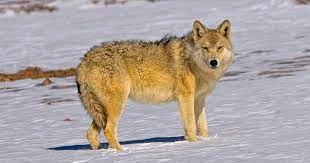Context:
The Himalayan Wolf has been assessed for the first time in the International Union for Conservation of Nature (IUCN)’s Red List.
Himalayan Wolf Declared ‘Vulnerable’ on IUCN Red List
- The assessment is based on a 2018 study led by a team of British and Nepalese researchers confirming the genetically unique lineage nature of the Himalayan or Woolly wolf.
- Himalayan wolf has now been categorised as ‘Vulnerable’ on the IUCN Red List with just 2,275-3,792 mature individuals in the wild remaining.
About Himalayan Wolves: Majestic Giants of the High Altitude Grasslands

- Scientific Name: Canis lupus Chanco
- Range Distribution: They are found in high altitudinal regions in the Himalayas and the Tibetan plateau of India, Nepal and China.
- Habitat: High altitude Grasslands
- Morphology: It is larger in size than the Indian and European wolves. They reach upto 110-180 cm in length, about 75 cm tall at the shoulder and weigh around 50 kg.
- Feeding habits: Their prey base includes yak, kiang, bharal, Tibetan gazelle, Siberian ibex, marmot and other small mammals like hare.
Himalayan Wolf Conservation Challenges: Human-Wildlife Conflict, Hybridisation, and Habitat Loss
-
Threats to Himalayan Wolf:
-
- Human-Wildlife Conflict: Encroachment and depletion of wild prey populations resulting in the animal coming in for livestock population.
- Feral Dogs: Hybridisation with dogs was an emerging threat to the Himalayan wolf population in Ladakh and Spiti where increasing populations of feral dogs pose a growing challenge.
- Hunting: They are illegally hunted for trade in its fur and body parts including paws, tongues, heads, and other parts.
- Losing Habitat: Their grassland habitat is constantly changing its nature due to climate change, encroachment, overgrazing, and human activities.
Conserving the Himalayan Wolf: Strategies for Prey Populations, Livestock Protection, and Public Awareness
- Securing and restoring healthy wild prey populations and landscapes and setting aside wildlife habitat refuges.
- Livestock Guarding Methods: Use methods such as predator-proof corral pens and using sustainable livestock herding practices, including reduced livestock loads, adapted herding.
- Management of feral dog populations
- Trans-boundary efforts in conservation of the species in range countries through research and monitoring.
- Improving herding/pasture management practices for Himalayan Wolf populations that are heavily dependent on livestock, like in Ladakh.
- Incorporating the Himalayan Wolf in conservation programmes, which may assist with promoting public acceptance and reducing persecution.
- India is also home to the Indian/Common/Peninsular Wolf (Canis lupus pallipes) found in the plains and the Deccan Plateau.
News Source: Down to Earth
![]() 13 Jan 2024
13 Jan 2024

